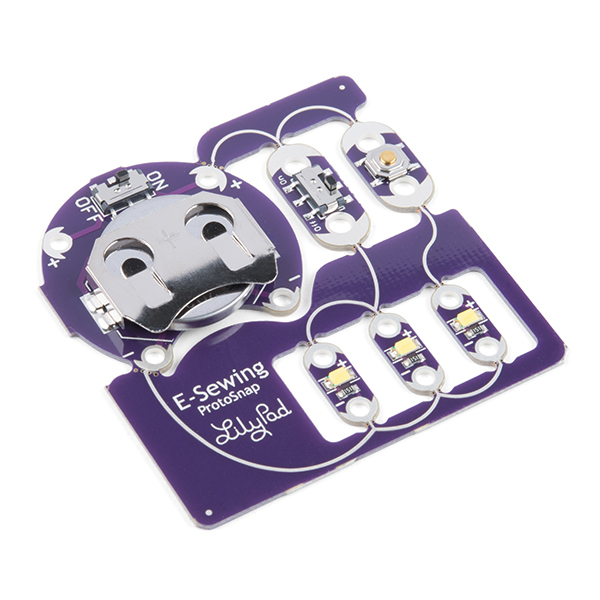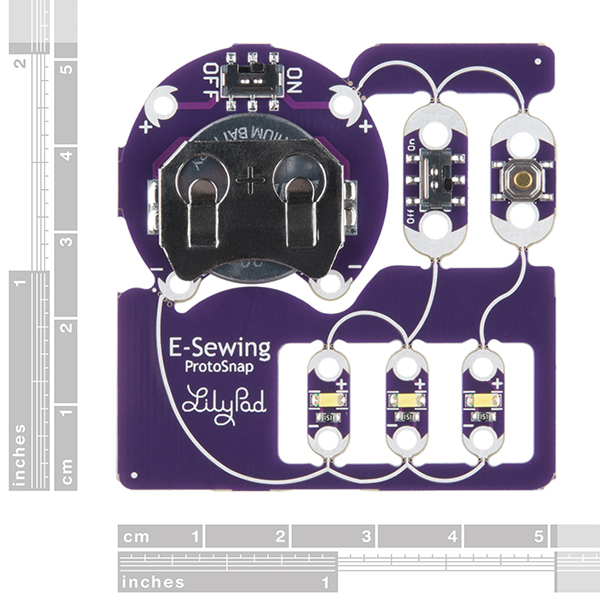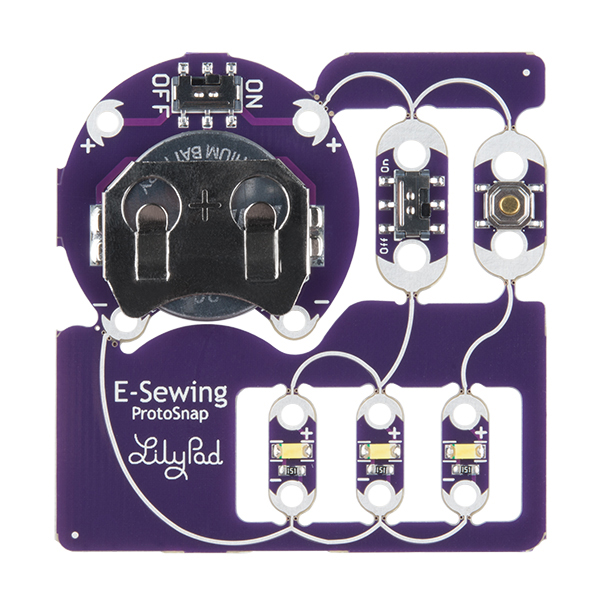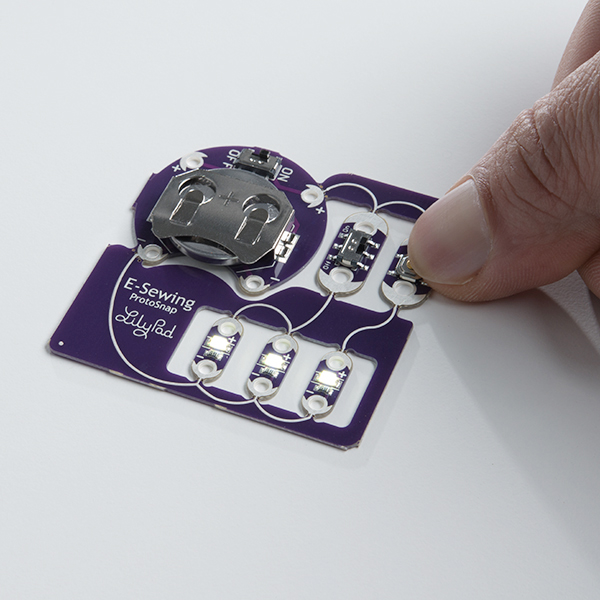LilyPad E-Sewing ProtoSnap
The LilyPad E-Sewing ProtoSnap is a great way to explore how buttons and switches behave in simple e-sewing circuits before crafting your project. Like other LilyPad ProtoSnap series boards, the individual pieces of the board are pre-wired --- allowing you to try out the function of the circuit before sewing. There is no programming required to use this ProtoSnap, and it can be used right away!
The E-Sewing ProtoSnap includes three white LilyPad LEDs: two connected to a LilyPad Slide Switch and one connected to a LilyPad Button Board. A LilyPad Coin Cell Battery Holder with a CR2032 coin cell battery provides all the power you need for the circuit. All you need to do is design how you want your project to be laid out, and then snap everything apart!
Note: A portion of this sale is given back to Dr. Leah Buechley for continued development and education in e-textiles.
Note: Due to the requirements of shipping the included battery, orders may take longer to process and therefore do not qualify for same-day shipping. Additionally, these batteries cannot be shipped via Ground or Economy methods to Alaska or Hawaii. Sorry for any inconvenience this may cause.
Included on the ProtoSnap:
- 1x LilyPad Coin Cell Battery Holder --- Switched
- 1x LilyPad Slide Switch
- 1x LilyPad Button Board
- 3x LilyPad White LED
Included in the Package:
- 1x LilyPad E-Sewing ProtoSnap
- 1x Coin Cell Battery --- CR2032
LilyPad E-Sewing ProtoSnap Product Help and Resources
LilyPad Buttons and Switches
July 23, 2018
Learn about the button and switch offerings in the LilyPad line and how to use them.
LilyPad E-Sewing ProtoSnap Hookup Guide
December 7, 2017
Explore the LilyPad E-Sewing ProtoSnap and learn how to build it into a project.
Getting Started with LilyPad
October 27, 2017
An introduction to the LilyPad ecosystem - a set of sewable electronic pieces designed to help you build soft, sewable, interactive e-textile projects.
Core Skill: DIY
Whether it's for assembling a kit, hacking an enclosure, or creating your own parts; the DIY skill is all about knowing how to use tools and the techniques associated with them.
Skill Level: Noob - Basic assembly is required. You may need to provide your own basic tools like a screwdriver, hammer or scissors. Power tools or custom parts are not required. Instructions will be included and easy to follow. Sewing may be required, but only with included patterns.
See all skill levels
Core Skill: Electrical Prototyping
If it requires power, you need to know how much, what all the pins do, and how to hook it up. You may need to reference datasheets, schematics, and know the ins and outs of electronics.
Skill Level: Rookie - You may be required to know a bit more about the component, such as orientation, or how to hook it up, in addition to power requirements. You will need to understand polarized components.
See all skill levels
Comments
Looking for answers to technical questions?
We welcome your comments and suggestions below. However, if you are looking for solutions to technical questions please see our Technical Assistance page.
Customer Reviews
4.5 out of 5
Based on 4 ratings:
Simple and fun
I like the kit as a basic introduction to low voltage electronics for my 7 year old daughter. Now she can electrify her creations safely and easily.
Everything was included, and it worked! The board was already configured in a way that I could teach series and parallel circuits. The students experienced success using the switches, then we took the board apart to make our e-sewing projects. Tutorial was also very helpful. Students ages: 9 years to 61 years. Each one had a working project at the end of the workshop.
This was my first purchase with SparkFun. I'm really enjoying learning how to use your products. The E-Sewing Protosnap is a great place to start. Thank you.
It’s a birthday gift
Please ask us in a couple months. Although the parts are very tiny for a 9 year old to sew, I am sure she will be excited to try sewing the circuits on a hat! She is quite competent at running stitch and loves detailed tech stuff. The concept of sewing circuits is super cute and fun!!!






I used this recently with sixth-grade students to complete a project on electricity. We sewed simple patterns on felt, drew out the circuits, and sewed parallel circuits. I was great! The loved it and they learned basic sewing in the process. You would be surprised how well the boys did! I have one suggestion that I will also post with the conductive thread item, you should make the conductive thread in two different colors so the students can keep track of positive and negative lines. Next time I do the project, I will have them use a Sharpie to die some of the thread RED for the positive lines.
Thanks, for your feedback.
I already replied to your other comment, but as a note for other customers on this page: I would test the die or Sharpie on a small section of the thread first to make sure it still provides a good electrical contact. There is a chance that the coating might act as an insulator and prevent the thread from functioning.
Just wondering if I'm the only one to see the face of a man with a mustache in the "main" picture above? (It's what got me to look at this product page...)
Yes, I'm pretty sure you are the only one :) now that you mention it I can see it, but you do have one active imagination!